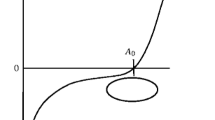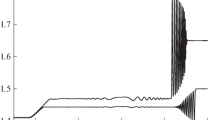Abstract
Experiments in which pressure pulses are propagated in a column of fluid held in a stiff tube are described. A parameter, η, which characterizes the tube stiffness has been defined and a one-dimensional model of the wave propagation which includes dissipation both in the volume of the fluid and at the wall of the containing tube has been developed. It is found that dissipation at the wall dominates dissipation in the fluid volume for pulse lengths long compared to the tube radius. The experimental results delineate practical limits on the ratio of pulse length to tube radius for which the wave propagation can be characterized as one-dimensional. The validity of a one-dimensional representation of pulse transmission and reflection at a solid-fluid interface is also evaluated with the aid of experimental results. Finally, the dissipation model in combination with the experimental results leads to a simple expression for pressure pulse attenuation in terms of a nondimensional physical parameter, Ξ, and tube radius.
Similar content being viewed by others
Abbreviations
- A :
-
area
- B :
-
fluid's bulk modulus
- c :
-
phase velocity
- c o :
-
acoustic velocity in the fluid
- E :
-
Young's modulus
- e x :
-
deviatoric strain in propagation direction
- f :
-
wave number
- p :
-
pressure
- r :
-
radius
- t :
-
time
- u :
-
particle displacement in propagation direction
- v :
-
particle velocity in propagation direction
- x :
-
distance
- α:
-
attenuation coefficient
- δ:
-
boundary-layer thickness
- e x :
-
strain in propagation direction
- η:
-
nondimensional tube-rigidity parameter
- Ξ:
-
nondimensional viscosity parameter
- Λ:
-
wavelength, pulse length
- μ:
-
viscosity
- ν:
-
Poisson's ratio
- ϱ:
-
mass density
- σ:
-
stress
- ω:
-
circular frequency
References
Kenner, V.H., “The Propagation of Compressive and Tensile Waves in a Fluid Column,”Int. J. of Mech. Scien.,20,373–383 (1978).
Kenner, V.H., “The Response of Blood to Transient Tensile Loading,” In press, J. of Bioengineering.
Jones, A.V., “Validation of a Cavitation Model and Its Application to Containment Loading Experiments,” Trans. of the Fifth Int. Conf. on Struct. Mech. in Reactor Tech.;E:Energetics and Struct. Dynamics in Fast Reactor Accident Anal., (T.A. Jaeger and B.A. Boley, Eds.), E2-6, Berlin (Aug. 1979).
Ripperger, E.A. and Abramson, H.N., “Reflection and Transmission of Elastic Pulses in a Bar at a Discontinuity in Cross Section,” Proc. 3rd Midwestern Conf. on Solid Mech., 135–145 (1957).
Lindsay, R.B., Mechanical Radiation, McGraw Hill, New York (1960).
Bolz, R.E. andTure, G.L. (Eds.),Handbook of Tables for Applied Eng. Science, Chemical Rubber Co., Ceveland, OH (1970).
Kenner, V.H., “One-dimensional Transmission and Reflection at Solid-fluid Interfaces,” Proc. of the 6th Canadian Congr. of Applied Mech., 239–240 (1977).
Kolsky, H., Stress Waves in Solids, Dover, New York (1963).
Merrill, E.W., “Rheology of Blood,”Physiol. Review,49,863–888 (1969).
Author information
Authors and Affiliations
Rights and permissions
About this article
Cite this article
Kenner, V.H. The fluid hopkinson bar. Experimental Mechanics 20, 226–232 (1980). https://doi.org/10.1007/BF02327705
Received:
Revised:
Issue Date:
DOI: https://doi.org/10.1007/BF02327705




